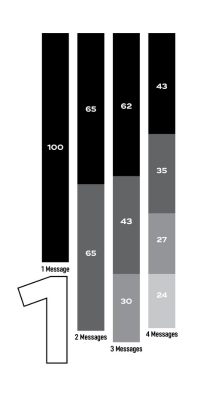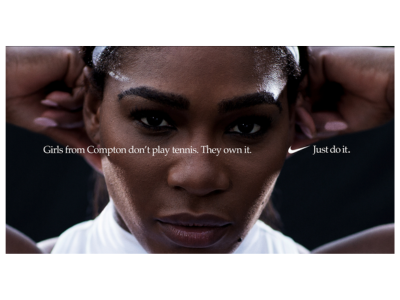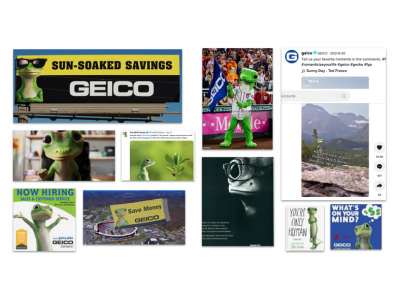John Drake has spent 27 years working in advertising agencies, primarily in strategy-driven roles. After many years of working with some of the largest brands in the US, he now specializes in growing middle market brands. John is a registered judge of creative effectiveness for the American Marketing Association, and his strategy work has received an Effie Award—the industry’s highest strategic honor—for creative insight, effectiveness, and results.
What advice do you have for other middle market executives seeking to improve their advertising performance, or better, turn it into a competitive advantage?
If we were to each sit down and list the brands that do the best advertising, I doubt our lists would be very different. Most of us would include Apple, Nike, and maybe GEICO. These brands create the most talked-about ads designed to grow awareness, capture interest, and
bolster lower-funnel performance marketing efforts. A core truth of great advertising is that the more compelling, visible, and memorable top-of-funnel ads are, the more leads come into the system, and the more market share is able to be gained.
But why are Apple, Nike, and GEICO on most peoples’ “best of” lists? Why can’t more brands do this high-caliber work? What might surprise people is that middle market companies are wonderfully built to do this type of advertising—they just may not realize it, or believe it.
So using research-based evidence, I’ll share what these three brands do and why it works. Then I’ll address why middle market companies have an advantage.
1. Saying One Thing.
Kantar/Millward Brown has done comprehensive research on advertising effectiveness. One of their greatest hits is putting data behind ad effectiveness once multiple messages are placed into one ad.
All companies have the number one, most important thing to say. When an ad only says that one thing, 100% of people remember that message. But the moment a second message is worked into an ad, now only 65% of people remember the main thing because the second thing is taking away attention. Add a third thing, and now the main message drops to 62%, and a fourth thing brings the main message down to only 43%.

Here’s how easily this can happen. A middle market food company that makes cheese says the most important thing to advertising is its superior taste, which everyone agrees to. But then someone says they should also say it's “artisan cheese,” so that’s worked into the ad. Another group sees what’s being developed and thinks it’s important to mention “sustainability,” because the company works hard on that, and then another team reminds everyone that their company is family-owned, which consumers like, so that’s added. The cheese ad runs with four messages, and only 43% of people remember the number one thing everyone wanted to say in the first place: superior-tasting cheese. Here’s Apple’s iPhone work. There’s one message–take amazing photos–which 100% of people get. Everything else is explained in other channels or in different parts of the customer journey.

2. Leading Into Emotion.
The Institute of Practitioners in Advertising (IPA) has done extensive research into the power of emotion in advertising. One of their discoveries is how emotional ads bring people into a brand more efficiently than logic-based ads do.
Emotion makes people feel something, and when we feel something, we’re more likely to remember it. As we journey through the marketplace as everyday consumers, we are prompted to act on things in a variety of ways outside of advertising: a visual cue, a need at home, word-of-mouth from others, etc. And when this happens, we most easily recall the brand that connected with us emotionally at an earlier time and take action.
Because of this easy recall, what the IPA’s analysis shows across their database of brands is that when emotional campaigns are run over the long term, they are twice as efficient at increasing total market share (per 10 points of excess share-of-voice) than rational ads.
Here’s an example of Nike’s work. It moves emotionally and doesn’t ask the audience to remember the logic of why Nike is better than Adidas or Under Armour. This approach–often using video–is one of the reasons why Nike holds 40% market share of global athletic footwear (source: Retail Dive, 2021).

3. Using One Creative Platform That Shows Up Across Multiple Channels.
The Journal of Advertising Research has been tracking how the number of platforms a brand uses affects advertising ROI. They discovered ROI increases for each platform that’s added to a campaign.

Data such as this should remind marketers that audiences are distracted. So when a brand takes one creative idea and then expresses it across many different channels, it has a greater propensity to entice action.
Advertisers might be surprised to learn that this strategy can be done with existing budgets if proper annual planning is done to align media strategies and production budget allocations.
This is what GEICO does. Recall how many places you’ve seen the gecko… on TV, on a banner behind an airplane, on the web, at a sports stadium, in an airport. The Gecko even wrote a book.

How Middle Market Companies Are Built To Do This Too
Nike, Apple, and GEICO are all huge brands that have somehow navigated needing many layers of approval and input to launch an ad.
When creative work is subjected to multiple layers of people to receive buy-in, things get added, questioned, reworked, and before it’s all done, the ad concept gets weaker.
Middle market companies have a natural advantage because they have fewer layers of decision makers. There is greater likelihood that an amazing concept remains focused on one key message, retains its emotional appeal, and keeps consistent across multiple channels. If you’re not taking advantage of a more streamlined corporate structure for creative approvals, you are releasing a competitive advantage you naturally have.
Doing this doesn’t mean keeping things closed off to other employees. In fact, it sounds counter-intuitive, but middle market companies can actually get more people involved upfront before creative development begins.
The middle market has a naturally collaborative nature. People outside of marketing can be invited to upfront brainstorms without crossing corporate boundaries. Involving people in more informal discussions or work sessions (sometimes with your agency partners) allows employees to be involved in the creative process yet keeps it away from trying to shoehorn feedback in an ad once it’s being circulated.
If middle market companies can involve employees early on and then focus the feedback once ads are created, they will be much more able to create focused, emotion-forward, multichannel advertising.
Remember, when it comes to your advertising, you are likely outspent, which means you need to outsmart. So don’t be afraid to say “yes” to an ad that says only one message, or leans into emotion over logic. Research is on your side that those tactics will be effective.
Background: Drake Cooper
Drake Cooper is an advertising and marketing agency that increases the value of mid-market companies using advertising, media, digital content and environments, data analysis, brand strategy, video and photography, and creativity.
With a motto of “building brands for the ambitious,” the agency works with clients around the country and has developed a reputation for having one of the most collaborative work styles in the industry. Drake Cooper specializes in working with mid-sized, growing brands and has tailored the agency’s services to be of maximum value to organizations that are largely outspent by larger competitors.
Drake Cooper was founded in 1978 and is one of the few employee-owned advertising agencies in the United States. The agency is known for its strategy and creativity, which has led to an agency-client relationship tenure of more than three times the industry average. Read more about Drake Cooper in their NCMM Company Spotlight here.